 If you are in the Ruger 10/22 frame of mind, and if the 10/22 Target model interests you, this article may be worth a read.
If you are in the Ruger 10/22 frame of mind, and if the 10/22 Target model interests you, this article may be worth a read.
The Ruger 10/22 Target, in the current models, is offered in two models; the 1121 and the 1262. While both are “Target” models, there are distinct differences between the two. This article serves as a side-by-side comparison between the two and also as a somewhat detailed account of the “Target Project.”
In my review of the Ruger 10/22 Target model 1262 (Ruger 10/22 Target (Model 1262) – Product Review: https://guntoters.com/blog/2016/12/18/ruger-1022-target-model-1262-product-review/), I mentioned that I felt Ruger got it wrong by placing the stainless-steel action with one stock while placing the alloy-steel action in another. Of course, a bit of this observation stems from personal preferences. I decided to purchase the Model 1121 and swap things out to come up with, which I thought, a better combination of action and stock. However, that is not the point of this article because what I consider as a preference may not be the preference of others. I simply want to point out obvious differences between the two models so that a person who has an interest in a target model of the 10/22 can make an educated choice. Then, I will take you through my personal “Target Project.”
THE BASICS:
First, we need to take a look at the basic specifications for each model and then move into some detail about each firearm that is provided by Ruger at its website.
Ruger Model 1121 and 1262 Comparison
| Model 1121 | Model 1262 | ||||
| Stock: | Brown Laminate | Black Laminate | |||
| Front Sight: | None | None | |||
| Rear Sight: | None | None | |||
| Material: | Alloy Steel | Stainless-Steel | |||
| Twist: | 1:16 RH | 1:16 RH | |||
| Capacity: | 10 | 10 | |||
| Finish: | Satin Black | Clear Satin | |||
| Weight: | 7.5 lb. | 7.5 lb. | |||
| Overall Length: | 38.50 in. | 38.50 in. | |||
| Barrel Length: | 20 in. | 20 in. | |||
| Grooves: | 6 | 6 | |||
| MSRP: | $579.00 | $629.00 |
Features for each version seem to be the same:
- Patented, detachable 10-round rotary magazine features a unique rotor to separate cartridges and provide reliable feeding.
- Legendary action, a tried and true Ruger design, ensures consistent, reliable performance.
- Easy-to-use extended magazine release provides smooth, no-fuss removal of flush-mounted magazine.
- Positive, push-button, cross-bolt manual safety.
- Combination scope base adapter for both Weaver-style and .22 tip-off scope mounts included.
- Cold hammer-forged barrel is locked into the receiver by a unique, two-screw, V-block system.
- Heat-stabilized, glass-filled, polymer trigger housing assembly is precision made of high-tech material for improved manufacturing tolerances, impact and abrasion-resistance and an unmatched ability to withstand the elements.
- Heavy, cold hammer-forged barrel with recessed target crown and spiral design.
- Unique two-stage target trigger features a short “take-up” stage, followed by a crisp, light target pull with no creep or over-travel.
- Flat buttplate with rubber butt-pad and sling swivels.
Now, to pick out the subtleties not mentioned in the features:
- Patented, detachable 10-round rotary magazine features a unique rotor to separate cartridges and provide reliable feeding. One magazine provided with firearm.
- Combination scope base adapter for both Weaver-style and .22 tip-off scope mounts included. A silver-colored mount comes with the stainless-steel version. A black mount is provided with the alloy-steel version.
- Cold hammer-forged barrel is locked into the receiver by a unique, two-screw, V-block system.
- Flat buttplate with rubber butt-pad and sling swivels (actually 1” loop sling mounts with no swivel feature) on black laminate (Model 1262) and brown laminate (Model 1121) stock.
When it comes down to it, it is really your preference of stainless-steel or alloy steel barrels –or- a preference between brown or black laminate stocks. The receiver is of the same material for both models and just the finish differentiates between the two. The trigger group and bolt group are the same for each model. Both barrels receive the swirl pattern with the alloy-steel barrel receiving a protective satin finish and the stainless-steel barrel receiving a polishing.
The stainless-steel barrel is, of course, less susceptible to corrosion than is the alloy-steel barrel, but does require care. Both; however, are subject to exterior wearing and unwanted scratches, scrapes, and such. The alloy-steel barrel could receive a more durable coating, such as Cerakote or some other fashionable protection. The stainless-steel barrel polishes well and most slight blemishes can be easily doctored. And, of course, either model’s barrel can be swapped out to a barrel of your desire, if you so desire, since the v-block barrel attachment system is used throughout the 10/22 line of firearms.
THE TARGET PROJECT OVERVIEW
The Target Project essentially started out as preparing a rifle for a course that I have been wanting to participate in for a long time – Project Appleseed. Because of timed events within the course, I simply wanted a good semi-automatic .22 caliber rifle with a good optic and trigger. The Ruger 10/22 Target rifle won out over several other manufacturers’ rifles. I had set up the Ruger 1262 to my liking, but I felt that I needed a back-up rifle just in case. I ordered the Ruger 1121 with a stock swap already in mind. I felt that the Ruger 1121, with its black swirled barrel, would look better in a black laminate stock and the 1262, with its stainless-steel swirled barrel would look better in a brown stock, which has nothing to do with the performance of the rifles; it was simply an aesthetic appeal kind of thing.
There were two considerations to take into account; optics and improving the triggers. Having some experience with the Ruger 10/22, there were also some other upgrades that were needed. The remainder of the article addresses the build for the Ruger 1121 and 1262 target rifles.
THE TRIGGER SUB-PROJECT:
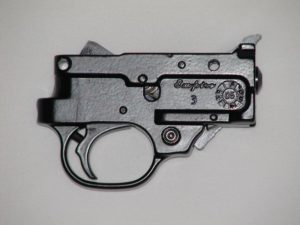
Ruger Standard Trigger Unit
The trigger group on both models are nearly identical in that the purpose, function, and feel attest to consistency of manufacturing and assembly. While the triggers on both models are much better than the trigger found on “standard” 10/22 firearms, it does not mean that the trigger is excellent. It is my opinion that the trigger could still be improved upon – either by replacement or custom tuning by a qualified gunsmith. My jury is still out whether the trigger on either model is better than the Ruger BX trigger system. For a “general” target rifle, the existing triggers would satisfy most. To the discerning target shooter; however, something would have to be done to better the triggers. I have compared the trigger on both models to the Ruger BX trigger, and I have to give the trigger pull weight edge to the BX unit. With that said, the triggers on my Model 1121 and Model 1262 are still brand new with not enough trigger pulls to determine if the action smooths out and/or lightens up with use.
The following is a comparison of the triggers in the 1121 and 1262 with the Ruger BX trigger:
Ruger 10/22 Target Model vs. BX Trigger Comparison
| RUGER BX TRIGGER | Ruger 1121 TRIGGER | RUGER 1262 TRIGGER |
| Releases at 2.5 to 3 Pounds | 3.11 pounds average, as measured with Lyman Trigger Pull Gauge. However, this may improve through use. | 3.6 pounds average, as measured with Lyman Trigger Pull Gauge. However, this may improve through use. |
| Crisp, Light Trigger Pull | Mostly true. Should improve with use. There is a very slight detectable creep, but not enough to even call it a creep. | Mostly true. Should improve with use. There is a very slight detectable creep, but not enough to even call it a creep. |
| Quick and Easy Drop-In Design | Installed as standard with the “Target” model | Installed as standard with the “Target” model |
| Minimal Over-travel | Agree | Agree |
| Positive Reset | Reset is almost at forward trigger limit. The reset point is audible and tactile. | Reset is almost at forward trigger limit. The reset point is audible and tactile. |
With all of the above mentioned, I decided to do something about the triggers, beginning first with the 1121 since the trigger on this rifle was the worse of the two 10/22 target rifles.
The trigger pull weight on the 1121 is about 3.11 pounds on average; far from the claim made by Ruger. I dug into the 10/22 parts bin where I keep all of my 10/22 parts that have accumulated through the years. I have two trigger units that I modified once before with Volquartsen target hammers and associated components. I had replaced them with the Ruger BX trigger on one other 10/22 and the Ruger Charger. One of these units gave me a problem with the trigger not returning to reset unless I pushed it forward with my finger, a result of a weak trigger return spring or some other affliction, and that issue was cured by returning to the stock Ruger trigger springs. So, I had two Volquartsen 10/22 trigger units with the sole purpose of aggravating each other in the 10/22 parts bin.
I checked both of the Volquartsen modified trigger units and decided that they were really not too bad after all. I knew that before I sat a scope on the 1121, one or both of these modified units were going to be tried out. If I decided to keep one of the units installed, then I’ll swap out the extended magazine release and automatic bolt release pieces.
The Ruger 10/22 is one of the best firearms to work on. The trigger group can be swapped out in a matter of minutes with (usually) nothing more than a Glock tool.
Ruger 1262 Trigger Unit Modifications:
The following is a summary of the modifications made to the Ruger 1262 trigger unit:
- Volquartsen Match Target Hammer and Sear
- Volquartsen Automatic Bolt Release
- Power Custom Competition Extended Magazine Release
The result is a smooth and crisp trigger with a pull weight of 2.5 pounds, a slight take-up, and no over-travel. I plan on replacing the Volquartsen target hammer with the Volquartsen Match Target Hammer and Sear to clean the trigger up even more to match that on the 1121.
Ruger 1121 Trigger Unit Modifications:
The following is a summary of the modifications made to the Ruger 1121 trigger unit:
- Volquartsen Match Hammer and Sear
- Volquartsen Automatic Bolt Release
- Ruger 10/22 Extended Lever – Black – FBA by Tacticool22
The result is a smooth and crisp trigger with a pull weight of 2.3 pounds, an extremely slight take-up, and no over-travel.
Both extended magazine releases work very well, are easily installed, and are well worth the money; it’s just a matter of preference as to the style the shooter wishes to choose.
Both rifles now exhibit very nice triggers that I consider adequate for my purposes of punching paper at precise points of aim (see, OPTICS).
TAKING STOCK OF THE SITUATION:
Laminated wood consists of two or more layers of wood, impregnated with glue and attached permanently to each other. The combination of the two pieces of wood, if laid out correctly, results in the separate pieces moderating the effects of changes in temperature and humidity. Modern laminates consist of 1/16 inch (1.6 mm) thick sheets of wood, usually birch, which are impregnated with epoxy, laid with alternating grain directions, and cured at high temperatures and pressures. The resulting composite material is far stronger than the original wood, free from internal defects, and nearly immune to warping from heat or moisture. Typically, each layer of the laminate is dyed before laminating, often with alternating colors, which provides a pattern similar to wood grain when cut into shape, and with bright, contrasting colors, the results can be very striking. The disadvantage of laminate stocks is density, with laminates weighing about 4 to 5 ounces (110 to 140 g) more than walnut for a typical stock.
While wood laminates have been available for many years on the custom market (and, in subdued form, in some military rifles), in 1987 Rutland Plywood, a maker of wood laminates, convinced Sturm, Ruger, Savage Arms, and U.S. Repeating Arms Company (Winchester) to display some laminate stocks on their rifles in a green, brown and black pattern (often called camo). The response was overwhelming, and that marked the beginning of laminated stocks on production rifles.
– Source: https://en.wikipedia.org/wiki/Stock_(firearms)#Laminated_wood
I have always favored wood for gun stocks, and while laminated gun stocks were deemed stronger and more weather-resistant than a sold chunk of wood, I still favored the more natural flow of patterns in a nicely selected walnut or maple wood gun stock. However, after seeing some beautiful renditions of laminated wood gun stocks, I have come to appreciate them more. Although I have firearms with injection-molded synthetic gun stocks, most simply do not add “soul” to the firearm as wood seems to.
What follows is a good and useful comparison between wood and laminate gun stocks.
| Appearance: | Wood stock gives the rifle a beautiful, classic, and elegant look. Laminated stock is dyed to give as close a finish as possible to wood but it is not as impressive as a wood stock. |
| Cost: | Laminated stocks are usually less expensive and solid walnut stocks are most expensive. |
| Weight: | A laminated wood stock is lighter in weight though sometimes it can be heavier than wood. The heavier the stock, the better the balance and lighter the recoil. |
| Manufacturing: | Wood stocks are easier to make than laminated stocks, such as laminated stocks require high pressure and temperatures to glue them together. |
| Durability: | Laminated stock offers better protection against natural forces like moisture and heat, unlike wood stock rifles that twist and swell with changes in weather. This is because the grains of wood are in different directions and this helps cancel any tendency to warp, making it extremely durable. |
| Stability: | Laminated rifle stock is the most stable and strongest of all stocks. |
 Ruger offers the 10/22 Target model with two wood laminate stocks; a brown laminate with the alloy-steel model (1121) and a black laminate with the stainless-steel model (1262). With that said, both stocks suffer from the effects of being produced on a large scale – blemishes and lack of quality finishing.
Ruger offers the 10/22 Target model with two wood laminate stocks; a brown laminate with the alloy-steel model (1121) and a black laminate with the stainless-steel model (1262). With that said, both stocks suffer from the effects of being produced on a large scale – blemishes and lack of quality finishing.
Admittedly, both stocks provided by Ruger serve the purpose for which they are intended in the firearm’s triad of components; provide a means to which the action (lock and barrel) is secured. These are, after all, production gun stocks and some slack has to be given because of that fact. In other words, don’t expect custom gun stock quality.
The brown laminate gun stock is better at hiding blemishes over the black laminate stock simply because of the nature of the stains used in the manufacturing process and the blending of the colors in a more natural finish such as brown. The black laminate stock is not as forgiving as the brown laminate gun stock in hiding blemishes.
Stocks; however, are well milled to accommodate the 10/22 action and should serve you well with their intended purpose. Some users, and because of the nature of the “Target” model, may opt to update the rifle with a custom unit designed for “target” use such as one with a thumbhole pistol grip and cheek riser or a fully-adjustable stock version. Customization is one of the features of the Ruger 10/22 that attracts many customers to this platform.
In the past, Ruger has offered the stainless-steel version in a brown laminate stock that I have always liked. However, the latest version of the 10/22 Target in stainless-steel is only offered in a black laminate stock. Since I have both models of the current target 10/22 rifles, I decided to make a project of them and swap out the actions; the stainless-steel version (1262) is now in the brown laminate stock and the alloy-steel version (1121) now is in the black laminate stock. The exchange was more for visual appeal than function; both would still be “target” rifles but with a different appearance.
Through my eyes, the alloy-steel action in the black laminate stock had more of a “tactical” look to it, and upgrade components were selected with that thought in mind. The stainless-steel version’s upgrade components had been selected and installed earlier and complemented the stainless-steel/silver combination of the action. Upgrade and scope mounting components for the alloy-steel version were selected in keeping with the black theme of the action while keeping with a somewhat “tactical” theme of the rifle that I was looking for.
UPGRADING:
While the Ruger 10/22 is an excellent firearm, there are a few upgrades that are necessary in my line of thinking:
| Trigger: | Discussed previously (see, THE TRIGGER SUB-PROJECT), one of the upgrades that the 10/22 (or Charger) cries out for is a better trigger. There are numerous options available from entire trigger unit swaps to simply changing a few parts inside of the standard trigger unit. The Ruger BX trigger is a good choice; however, installing the Volquartsen Target Match Hammer and Sear seems to be a better solution for an excellent trigger. |
| Bolt Stop Pin: | Replace the steel bolt stop pin with a polyurethane unit to quiet the action and help protect the receiver. Volquartsen and Tuffer Buffer products are excellent; however, the Volquartsen buffer pins are much more expensive than the Tuffer Buffer pins. |
| Extended Magazine Release: | Assist in making magazine changes quicker and smoother. Simply push down on the extended lever and the magazine drops free. I have had no problems with inadvertently releasing a magazine with these devices. |
| Automatic Bolt Release: | Reduce the fumbling that takes place with the standard bolt release when trying to close the bolt after it has been locked back. With this unit, all I have to do is pull the bolt lever to the rear and let it go; there is no more fumbling with a persnickety bolt release. |
| Sights/optics: | While there are a plethora of sight options for standard 10/22 carbines, a magnified optic is a necessity for the Ruger 10/22 target models. See THE OPTICS SUB-PROJECT for my choice of magnified optics for the “Target Project.” |
There are other upgrades available, such as components for locking the bolt back on the last round and extended operating handles, but I consider these upgrades a nicety and not a necessity.
For the black laminate “Tactical Target” version, I was going to use a Monstrum Tactical Ruger 10/22 Picatinny Rail Mount for scopes (Product X000MWB09R) in lieu of the Weaver-style mount provided by Ruger. I felt that the Picatinny rail would provided more optic mounting options. However, the Monstrum unit is taller that the rail provided by Ruger, I didn’t care for the look of the mounting screws provided with the Monstrum unit – they seemed not to be as good of quality as the mounting screws provided by Ruger, and the mounting screws provided by Ruger would have been too short (in my opinion) to adequately secure the Monstrous rail to the receiver. The Monstrum rail was out and the Ruger provided rail would have to do.
Trigger upgrades were addressed in THE TRIGGER SUB-PROJECT. For general use, the triggers provided by Ruger are probably fine for most folks. I simply like my Ruger 10/22 triggers are little better than what Ruger provides. Although the Ruger BX trigger is much better than the trigger provided with the 10/22, the Volquartsen modification of the standard trigger unit turned out to be better than the BX trigger. With that said, if you are not comfortable with diving into trigger housings, the Ruger BX trigger would be an excellent choice for a quick trigger fix.
The black laminate stock and brown laminate stocks have received new sling swivel mounts to accommodate a bipod and/or sling. Sling swivels are 1″ QD units from Uncle Mike’s. which allow me to quickly attach and detach slings and bipod units as desired.
 I ordered two slings for the rifles from Amazon. They are simple two-point slings, are not quickly adjustable, but are made from Buffalo Hide by the Amish. One sling is in a “distressed” brown (Crazy Horse brown, as referred to by the manufacturer) that will go well with the 1262 action mounted in the brown laminate stock. The other sling is in black Buffalo hide and will look great with the 1121 action mounted in the black laminate stock. Heck, if I don’t know how to run a simple sling by now, I need to go back to school. While I have a couple of “Tactical” quick-adjust slings around here, I have no intention of going into battle with a 10/22 target rifle. I just want a couple of good-looking target-grade rifles.
I ordered two slings for the rifles from Amazon. They are simple two-point slings, are not quickly adjustable, but are made from Buffalo Hide by the Amish. One sling is in a “distressed” brown (Crazy Horse brown, as referred to by the manufacturer) that will go well with the 1262 action mounted in the brown laminate stock. The other sling is in black Buffalo hide and will look great with the 1121 action mounted in the black laminate stock. Heck, if I don’t know how to run a simple sling by now, I need to go back to school. While I have a couple of “Tactical” quick-adjust slings around here, I have no intention of going into battle with a 10/22 target rifle. I just want a couple of good-looking target-grade rifles.
THE OPTICS SUB-PROJECT:
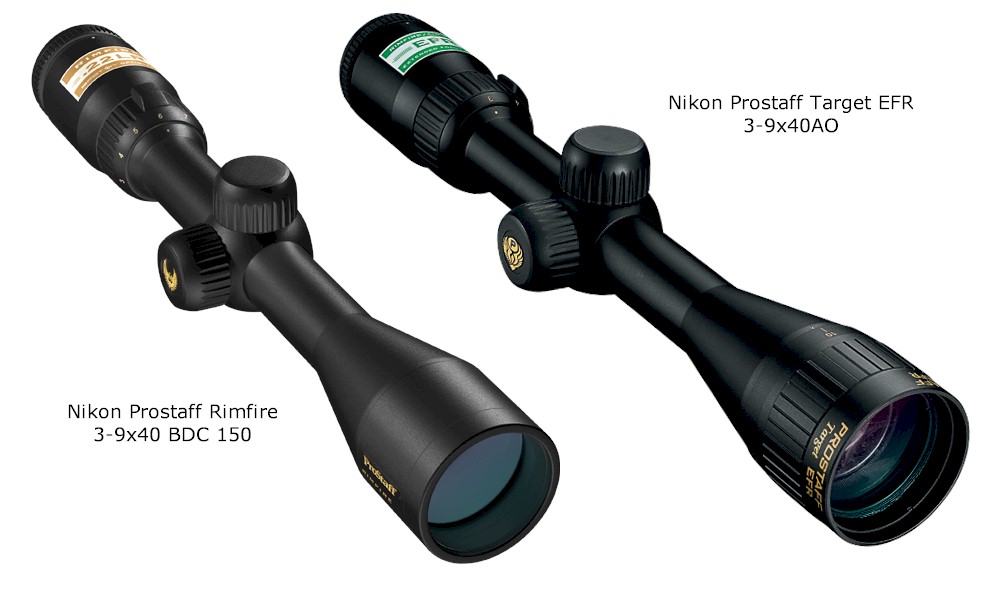 Two magnified optics were selected to help these old eyes see the target; a Nikon PROSTAFF Rimfire BDC 150 scope and a Nikon Prostaff Target EFR 3-9×40 AO Matte Precision Reticle scope.
Two magnified optics were selected to help these old eyes see the target; a Nikon PROSTAFF Rimfire BDC 150 scope and a Nikon Prostaff Target EFR 3-9×40 AO Matte Precision Reticle scope.
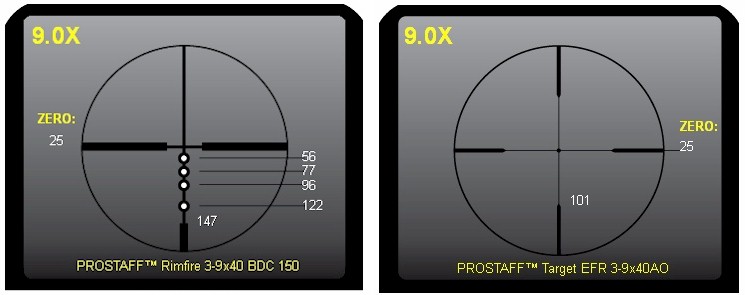
The Nikon PROSTAFF Rimfire BDC 150 scope had been mounted on the 1262 previously. Although it is an extremely nice magnified optic, I wanted something else for the 1121 and the Nikon Prostaff Target EFR 3-9×40 AO would fit the bill.
A comparison between the Nikon Prostaff Target EFR 3-9×40 AO and Nikon PROSTAFF Rimfire II BDC scope is shown below in Table 2. Differences between the two scopes are highlighted.
Nikon Scope Comparison
| Nikon Prostaff Target EFR 3-9×40 AO | Nikon PROSTAFF Rimfire BDC 150 | |
| Magnification: | 3 – 9 x | 3 – 9 x |
| Objective Diameter: | 40 mm | 40 mm |
| Exit Pupil: | 4.4 – 13.3 mm | 4.4 – 13.3 mm |
| Field of View: | 5.7 – 16.9 ft @ 100 yds | 11.3 – 33.8 ft @ 100 yds |
| Tube Diameter: | 1 in | 1 in |
| Eye Relief: | 3.6 in | 3.6 in |
| Objective Outside Diameter: | 50 mm | 50 mm |
| Eyepiece Outside Diameter: | 44 mm | 44 mm |
| Weight: | 15.7 oz | 13.6 oz |
| Overall Length: | 12.5 in | 12.4 in |
| Adjustment Graduation: | 1/4 in | 1/4 in |
| Max Internal Adjustment: | 80 MOA | 80 MOA |
| Zero reset Turrets | Yes | Yes |
| Parallax Setting: | 50 yds – ∞ | 50 yds |
| Adjustable Objective: | Yes | No |
| Waterproof/Fogproof: | Yes | Yes |
| Parallax Adjustment: | Yes | No |
| Matte Finish: | Yes | Yes |
| Use: | Rimfire | Rimfire |
| Reticle: | Precision | BDC |
A set of Weaver 1″ Medium Grand Slam Steel Top-Mount Rings in satin black was used with the 1262 Nikon PROSTAFF Rimfire BDC 150 scope mounted on the 1262; however, a set of rings in for the Nikon Prostaff Target EFR 3-9×40 AO mounted on the 1121 proved to be a challenge. I felt that the gloss black would contrast nicely with the receiver/mount/scope combination. It took several sets of gloss black scope rings before I realized that I was never going to match the black of the barrel to any set of scope glossy black scope rings. I finally settled on a set of AIM Sports 1” medium scope rings, which provided me with the contrast that I was looking for and enough barrel-to-scope clearance. With that said, I still wasn’t satisfied and opted for a set of Leupold Rifleman 1″ Medium rings that provided better barrel-to-scope clearance and provided more of the look that I wanted for the 1121.
I found that scope rings were the most difficult component to select, while most components for the “Target Project” were easy to choose. I have written an article regarding scope rings (Optic Rings and Demonic Possession: https://guntoters.com/blog/2016/12/25/optic-rings-and-demonic-possession/).
ACCURACY TEST:
The Ruger 1262 was shot earlier than the Ruger 1121 and turned in some impressive results accuracy-wise. The Ruger 1121 is also no slouch in the accuracy department..
Below is range results for both rifles. The Ruger 1121 or Ruger 1262 target fields would serve you well.

SUMMARY:
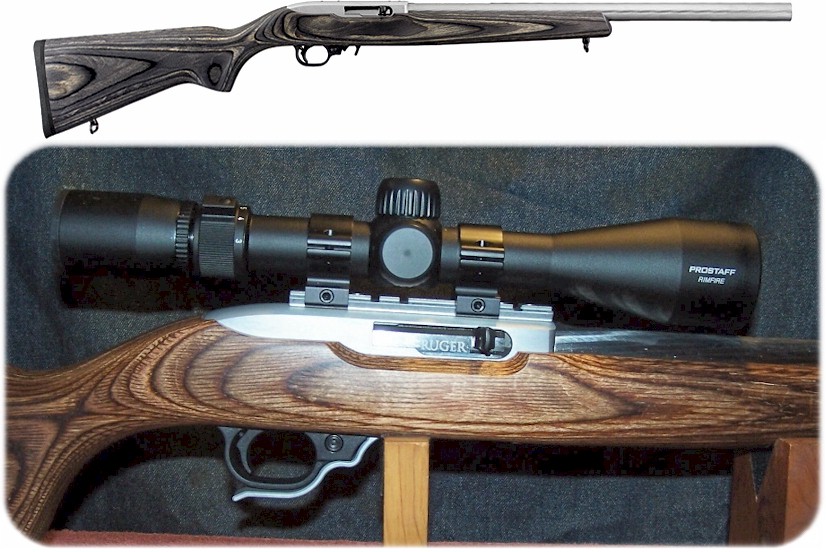
Ruger 1262 Before (Top) and After (Bottom)
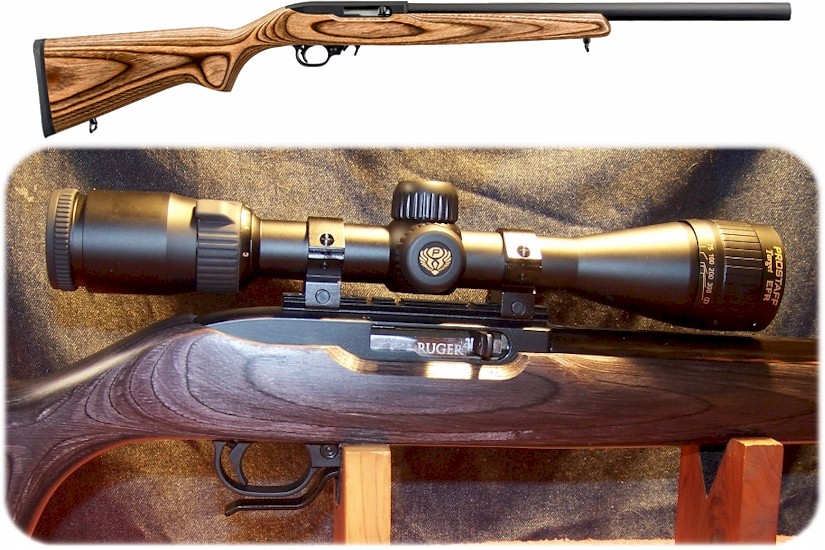
Ruger 1121 Before (Top) and After (Bottom)
The “Target Project” was intended to make each Ruger 10/22 Target model distinct in their personalities and components were installed that, I felt, fit the personality of each rifle suitable to my taste.
I leave improvements and customization of the rifle up to the taste and preferences of the shooter. I simply have shared my simple and conservative changes to each firearm for this project.
Links to all parts used in the project are provided in RESOURCES FOR THE PROJECT.
REFERENCES:
- Stocks: http://www.gunsgunsguns.com/gunhoo/p.stocks.htm
- Stock (firearms): https://en.wikipedia.org/wiki/Stock_(firearms)
- Cerakote Firearm Coatings: http://www.cerakoteguncoatings.com/
- Ruger 10/22 Trigger Group Assembly Disassembly: https://www.youtube.com/watch?v=HZjfAM4ytbU
- Ruger 10/22 Takedown Bolt Removal and Assembly: https://www.youtube.com/watch?v=cZs9RwlT5so
RESOURCES FOR THE TARGET PROJECT:
- Ruger 10/22 Target (Model 1121): http://ruger.com/products/1022Target/specSheets/1121.html
- Ruger 10/22 Target (Model 1262): http://ruger.com/products/1022Target/specSheets/1262.html
- Nikon Prostaff Target EFR 3-9×40 AO Matte Precision Reticle, Black: http://www.nikonsportoptics.com/en/Nikon-Products/Riflescopes/PROSTAFF-Target-EFR.html
- PROSTAFF 3-9×40 Rimfire Matte BDC 150: http://www.nikonsportoptics.com/en/nikon-products/riflescopes/prostaff-3-9×40-rimfire-matte-bdc-150.html
- Uncle Mike’s QD 115 RGS Bolt Action Wood Screw Type Sling Swivels (Blued, 1-1/4-Inch Loop): https://www.amazon.com/gp/product/B0009TTROW/ref=od_aui_detailpages00?ie=UTF8&psc=1
- Weaver 1″ Steel Top-Mount Grand Slam Rings Medium Matte 49303s: https://www.cheaperthandirt.com/product/weaver-1-steel-top-mount-grand-slam-rings-medium-matte-076683493033.do?sortby=ourPicks&refType=&from=Search
- Leupold Rifleman Detachable Rings (Gloss Black): https://www.amazon.com/gp/product/B0007KX4P6/ref=od_aui_detailpages00?ie=UTF8&psc=1
- Weaver Grand Slam Lever Lok Top 1-Inch Medium Mount Rings (Gloss Black): https://www.amazon.com/gp/product/B00162OPIY/ref=od_aui_detailpages00?ie=UTF8&psc=1
- Volquartsen Custom Target Hammer for 10/22 and 10/22 Magnum: https://www.amazon.com/Volquartsen-Custom-Target-Hammer-Magnum/dp/B0029M2FYQ/ref=sr_1_1?ie=UTF8&qid=1482430184&sr=8-1&keywords=10+22+volquartsen
- Volquartsen Automatic Bolt Release Ruger 10/22: http://www.midwayusa.com/product/688102/volquartsen-automatic-bolt-release-ruger-10-22?cm_mmc=se_service-_-shippingconf-_-shippingconf-_-ProductShippedTodayLink
- Power Custom Competition Extended Magazine Release Ruger 10/22 Aluminum: https://www.midwayusa.com/product/160459/power-custom-competition-extended-magazine-release-ruger-10-22-aluminum
- Ruger 10/22 Extended Lever – Black – FBA by Tacticool22: https://www.amazon.com/gp/product/B00Q39GFB0/ref=od_aui_detailpages00?ie=UTF8&psc=1
- Tuffer Buffer (bolt stop buffer pin): http://www.tufferbuffer.com/
- Recoil Buffer for 10/22 and 10/22 Magnum: https://www.volquartsen.com/inventory_configurations/814
- Buffalo Hide Leather Rifle Gun Sling, Black/black Stitch Amish Handmade 1″ Wide: https://www.amazon.com/gp/product/B018CUA77U/ref=od_aui_detailpages00?ie=UTF8&psc=1
- Buffalo Hide Leather Rifle Gun Sling, Crazy Horse/brown Stitch Amish Handmade 1″ Wide: https://www.amazon.com/gp/product/B018CUSKDS/ref=od_aui_detailpages00?ie=UTF8&psc=1
![]()

